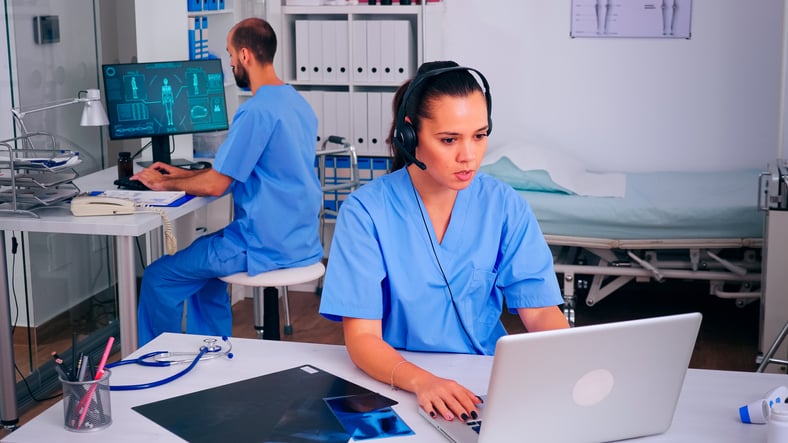
Universities and learning institutions are dynamic environments where knowledge is shared, discoveries are made, and the next generation of healthcare professionals is shaped.
In such a demanding and evolving setting, it's crucial to provide students, faculty, and staff with the best possible resources and facilities.
This is where ergonomics in healthcare education comes in, paving the way for a comfortable and sustainable learning environment.
Why Ergonomics is Important in Healthcare Education
Universities and learning institutions are increasingly investing in ergonomic medical equipment to improve the health and well-being of their students, faculty, and staff. This is due to several factors, including:
- The rising prevalence of musculoskeletal disorders (MSDs) among students and academics: MSDs are injuries and disorders that affect the muscles, tendons, bones, and nerves. They are often caused by repetitive movements, awkward postures, and prolonged periods of sitting or standing.
- The increasing awareness of the importance of ergonomics in preventing MSDs: Ergonomics is the study of how to design workplaces and tools to fit the human body. Ergonomic medical equipment is designed to reduce the risk of MSDs by providing support and comfort to the user.
- The growing demand for high-quality healthcare services on university campuses: Many universities now have their own health clinics and hospitals, requiring various ergonomic medical equipment.
Types of Ergonomic Medical Equipment Universities Need
The types of ergonomic medical equipment that universities need vary depending on the specific user needs. However, some common types of equipment include:
- Medical workstations and chairs: Provide support and comfort to the user, helping to reduce the risk of MSDs.
- Adjustable standing medical desks: Allow users to alternate between sitting and standing throughout the day, which can help reduce the risk of MSDs and improve overall health and well-being.
- Ergonomic keyboards and mice: Reduce strain on the wrists and hands.
- Ergonomic medical beds and patient lifts: Provide support and comfort to patients while protecting healthcare workers from injuries.
- Ergonomic multi-monitor setup and monitor arms: Help position the monitor at an optimal height to reduce neck and eye strain.
- Computers on Wheels: Allow healthcare professionals to move their computers with them, reducing strain from reaching or twisting.
- Blood draw tablet: Provides a stable surface for drawing blood, reducing the risk of needlestick injuries.
Download Our Free Ergonomic Equipment Integration Checklist for a Handy Reference Guide!
By following this checklist and incorporating ergonomic principles into your medical facility, you can create a safer, more comfortable, and more productive work environment for your staff, ultimately leading to better patient care and improved outcomes.
6 Benefits of Ergonomics for Medical Universities
The medical field demands physical and mental rigor. From long hours in labs to intricate surgeries, the risk of MSDs looms large. Fortunately, a proactive approach to ergonomics can not only safeguard the health and well-being of this vital community but also unlock a multitude of benefits for the university as a whole, including:
- Reducing the risk of MSDs among students, faculty, and staff: Ergonomically designed medical equipment can help to reduce the risk of MSDs, which saves universities money on healthcare costs and lost productivity.
- Improving the health and well-being of students, faculty, and staff: Ergonomic medical equipment can help improve the health and well-being of students, faculty, and staff, leading to better academic performance, increased job satisfaction, and reduced absenteeism.
- Improving productivity: Students and staff can focus on their work more effectively in comfortable and ergonomic environments, improving academic performance and research output.
- Enhancing the reputation as a health-conscious institution: Investing in ergonomic medical equipment can help universities strengthen their reputation as health-conscious institutions. This can make them more attractive to students, faculty, and staff.
- Creating a more positive and welcoming environment for students and staff: When people feel that their employer or institution is invested in their health and well-being, they are more likely to be motivated and engaged.
- Meeting ergonomic standards and regulations: Providing ergonomic medical equipment ensures institutions remain compliant and maintain a safe environment for students, faculty, and patients.
Want to Learn More About Ergonomics?
Download our free Manager's Equipment Guide for a Healthy Ergonomic Setup today:
How to Choose the Right Medical Ergonomic Equipment for Healthcare Education
Think beyond the classroom. Choosing the right medical ergonomic equipment today can prevent future healthcare costs, lost productivity, and talent drain, paving the way for a healthier and more sustainable future for your institution.
When choosing ergonomic solutions for your university, consider the following factors:
- The specific needs of your students, faculty, and staff: What types of ergonomic medical equipment will they need to do their jobs safely and efficiently?
- The size and budget of your university: Ergonomic medical equipment can be expensive, so it’s important to choose equipment that fits your budget and the needs of your university.
- The quality of the equipment: Choosing ergonomic medical equipment that’s well-made and durable means you will have long-lasting support that won’t bust your budget.
- The availability of training and support: Staff and students should be properly trained on how to use the equipment safely and effectively. Some manufacturers may also offer training or support services.
- The ease of customization: Some ergonomic equipment can be easily adjusted to fit the needs of different users.
- Flexibility and adaptability: Equipment that can be used in multiple scenarios and settings offers greater value.
Ergonomics in Healthcare Education: Investing in the Future
Ergonomics in healthcare education is not just a trend but a vital investment in the future of healthcare.
By prioritizing ergonomic principles and equipment, educational institutions are not only enhancing the learning environment but also contributing significantly to the development of skilled, efficient, and healthy healthcare professionals.
Contact Us for Ergonomic Expertise
Weber Knapp is here to help you create ergonomically supportive environments! Our team of experts can analyze your specific needs and recommend ergonomic designs tailored to your workspace and budget.
Whether it's choosing the perfect adjustable desks and chairs, implementing keyboard trays and monitor arms, or finding innovative storage solutions, Weber Knapp can guide you every step of the way.
.png?width=12000&height=2033&name=WeberKnappLogo_white%20(1).png)




